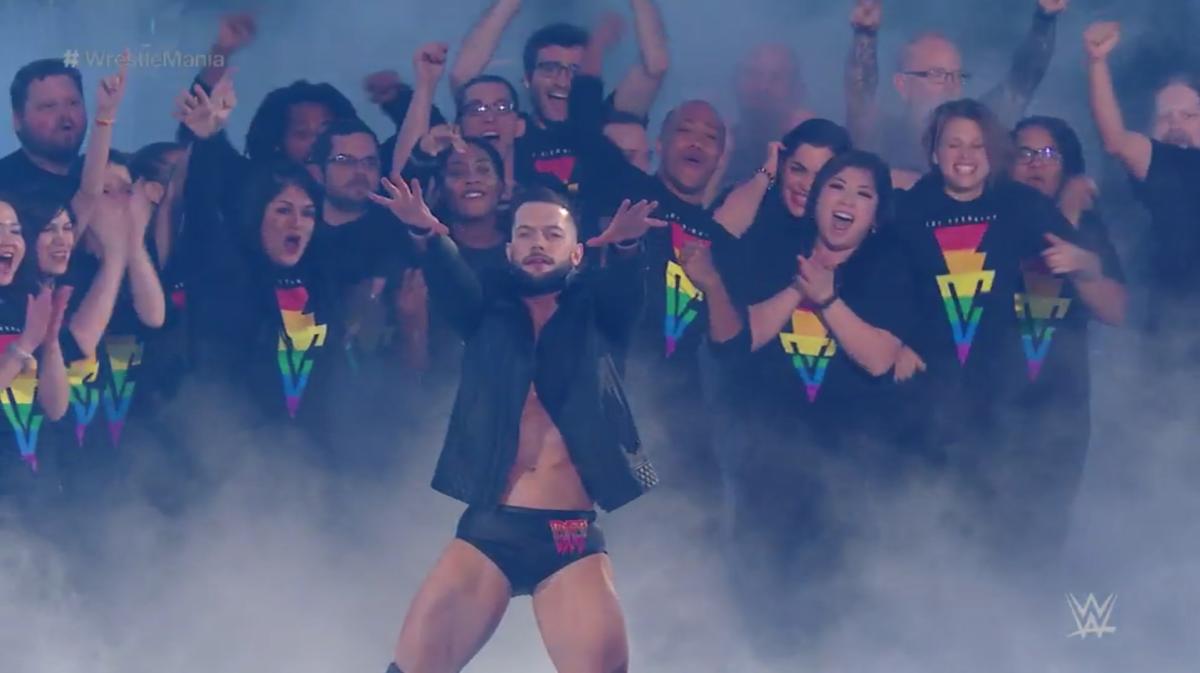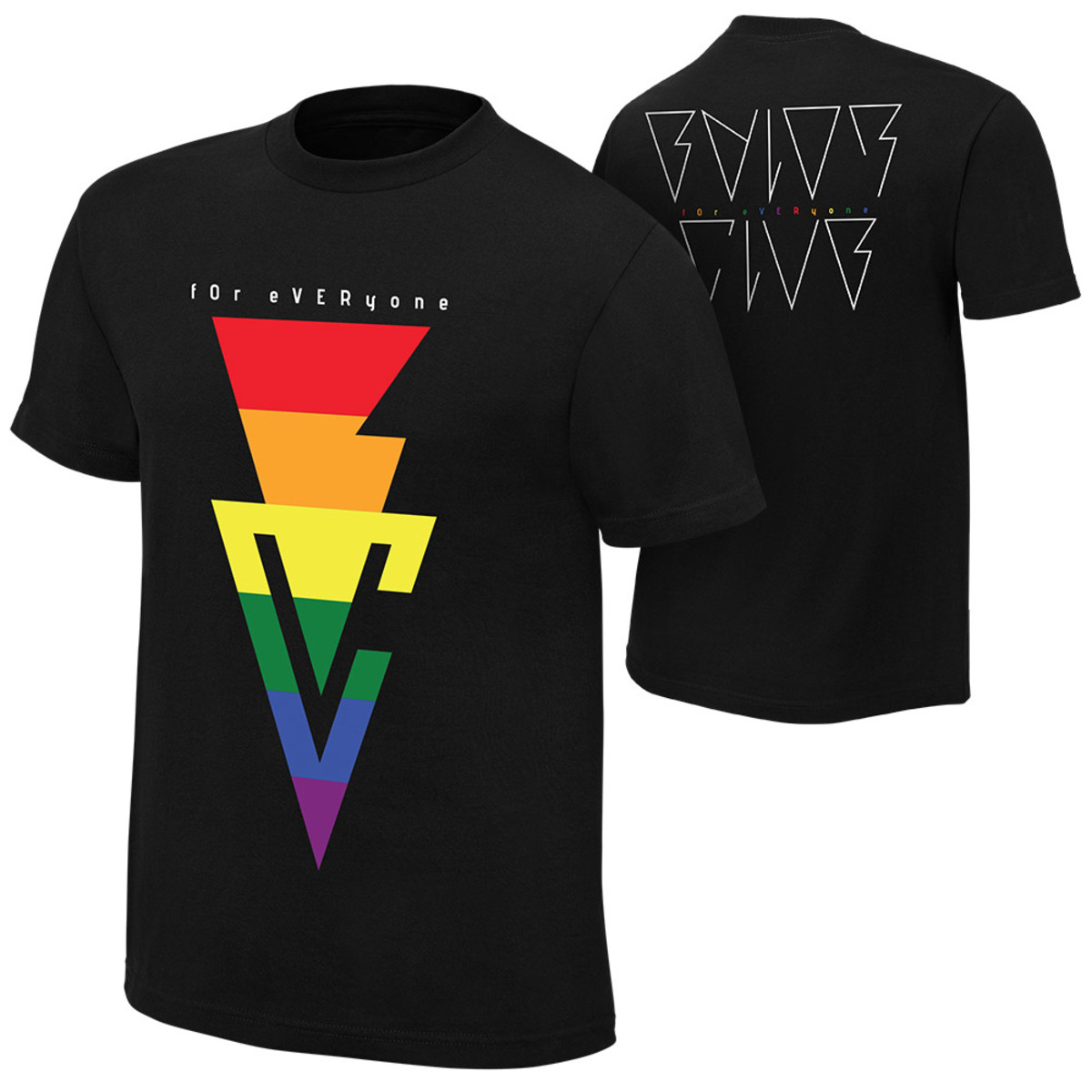Balor Club Is for Everyone: Finn Bálor Fights Hard to Make Wrestling an LGBTQ-Inclusive Environment

Even among the many anticipated aspects of this past April’s WrestleMania, Finn Bálor’s entrance held its own particular intrigue. Bálor, after all, has long distinguished himself not only through in-ring performances but also via the extravagant pomp with which he approaches the ring. Prior to joining WWE in 2014, that might entail cosplaying as demented fictional characters like the Joker or Hannibal Lecter; in WWE, it has meant inhabiting “the Demon King,” a more-aggressive, heavily body-painted version of his character that is typically saved for his most significant matches. For his Intercontinental Championship match with the Miz and Seth Rollins at WrestleMania—Bálor’s first at the company’s premier annual event—fans buzzed about whether he would appear as this alternate persona and what theatrics might accompany his doing so.
What viewers saw instead was a surprise of a different sort. Bálor, whose match opened the show, appeared on the gigantic stage that night in New Orleans without a dot of paint. And rather than standing there alone, he was flanked by some two-dozen cheering supporters clad in black T-shirts bearing rainbow-striped versions of his logo, which also graced the back of Bálor’s leather jacket and matched the patterns on his trunks and boots. When Bálor lifted his arms, the normally black-and-white name display on the screen behind him became multicolored as well. In case the visual message didn’t translate, WWE’s announcers made explicit that this was Bálor’s “message of inclusion” and support for the LGBTQ community.

“A lot of people maybe thought going into WrestleMania, ‘Well, if Finn’s not gonna be the Demon, it’s gonna suck,’” Bálor says. “I think what we did at WrestleMania is a lot more important than any Demon could have been.”
That entrance was the most prominent statement yet in what has become one of Bálor’s missions: to help professional wrestling be a welcoming and inclusive space for fans of all identities. In March, Bálor began wearing the “for everyone” shirt on air, which WWE released for sale the first week of April, leading up to WrestleMania. Along with the ROYGBIV coloration of Bálor’s logo—an interlocking B.C., standing for Bálor Club, a nickname for his fans—the shirt features the phrase “for everyone” on both its front and back, and 20% of each shirt’s sales price is donated to GLAAD. Bálor’s wearing it during his entrance marked the type of on-screen, in-character expression of support for a marginalized social group that has been historically rare in professional wrestling.

By the time he first wore the shirt on air, Bálor had been developing the idea for some six months. Speaking with friends in the LGBTQ community and living for the past year in Brooklyn, Bálor says, helped him realize that his industry could do more to support an underrepresented segment of its audience.
“I feel like—not that they were excluded, but sometimes they felt like they weren’t included,” says the 36-year-old Irishman. “That’s something I felt a responsibility for, to use the platform that I have for good and to help maybe a small amount of people for the right reasons.”
His proposal for the T-shirt design initially stalled for months within the slow-churning bureaucracy of WWE’s merchandising operation. In February, Bálor decided to take action of his own, commissioning a friend to draw up a rainbow version of his Bálor Club symbol that he posted to Instagram with the caption “BálorClub is for EVERYONE.” The response was immediate and encouraging.
“I’m not one for reading comments or reading what people say online because generally there’s a lot of negativity,” Bálor says. “But I had a lot of messages from friends, DMs and stuff, that were saying, ‘This meant so much for us.’”
The post also caught the eye of Stephanie McMahon, the WWE’s chief branding officer. She reached out to Bálor not only to compliment his message but also to get the company’s promotional machine behind his efforts.
“It’s crazy because it was kind of a couple months of me talking,” Bálor says, “then as soon as the right people heard it, it was almost instantaneously, ‘We gotta have this shirt out next week and we gotta talk to GLAAD ASAP and we’re gonna roll with it.’”
Forreal
— Finn Bálor (@FinnBalor) April 2, 2018
Forever
Foreveryone pic.twitter.com/uqgLeZW4Bw
Generally speaking, pro wrestling’s history of LGBTQ support has been something worse than checkered. As far back as the legendary 1950s villain Gorgeous George, the industry—which has long employed caricatures of various identities to create its broad-stroke characters—has often used gay stereotypes as punchlines or means of establishing a performer’s villainous bonafides. In the mid-90s, the antagonistically androgynous WWE heel Goldust signaled his transformation into a fan favorite by denying that he was a “queer.” A few years later, in 2002, the homoerotic tag team Billy and Chuck were set for a storyline commitment ceremony on an episode of SmackDown, only for the event to be sabotaged by rivals and the characters to announce their romance was a publicity stunt. (This earned WWE a rebuke from GLAAD, with which it later began partnering on anti-bullying campaigns in 2011.)
But has popular culture has evolved in recent decades, so too has wrestling, if more slowly. Such storylines have been absent from WWE programming for years; it’s also easier than ever to look around the wrestling landscape at large and see popular, strong characters who are sexually ambiguous or embrace less-traditional modes of masculinity: rising NXT star Velveteen Dream, Ring of Honor champion Dalton Castle, the New Japan tandem of Kenny Omega and Kota Ibushi, known as the Golden Lovers.
Still many have embraced a message as direct as Bálor’s, from a position as prominent as his, as a major step towards representation and inclusion. To have seen such a gesture as a young wrestling fan “would have meant everything,” says Joe Dombrowski, a 32-year-old commentator for Ring of Honor and other independent promotions, who came out as gay two years ago. Dombrowski was in attendance at WrestleMania, where Bálor’s entrance resonated with him so much that he bought the associated shirt, the first Dombrowski had purchased from WWE in roughly 15 years.
“I’m sure there are kids out there 11, 12, 13 years old who are just coming to grips with what they are and they have a lot of questions and a lot of fears,” says Dombrowski. “And they need something like that. This is gonna help ensure that they have a better childhood than I did.”
Representation for LGBTQ fans within mainstream wrestling has traditionally been scarce. In 2013, Fred Rosser—who wrestled in WWE as Darren Young from 2010 until last year—became the first active WWE superstar to come out publicly, but his character’s sexual orientation was only referenced with winking innuendo. (For Rosser, who notes WWE and Vince McMahon fully supported him after coming out, the timing of Bálor’s entrance stung. “For them to release me,” he says, “and then to do this amazing LGBTQ representation at the opening of WrestleMania, it broke my heart that I wasn’t able to be there.”) On its current roster, Sonya Deville is the only out performer.
Deville too made a statement at WrestleMania: for the pre-show 20-woman battle royal, she performed in a rainbow-patterned outfit of her own. Bálor says Deville was one of a number of people who approached him supportively backstage at the show, a sentiment that has been echoed en masse from fans online and at shows.
“I’ve had messages from fans who’ve said I’ve inspired them to come out to their family,” Bálor says. “It’s incredible... What we do in WWE in the ring is important, but what we do and what we stand for outside of the ring is a lot more important.” Some people had warned him that he might risk alienating those who do not feel the same way that he did. “My answer was if those people think like that, I don’t necessarily want them as my fans,” Bálor says. “That was a risk I was willing to take.”
In the two months since WrestleMania, Bálor has returned to primarily wearing his usual monochrome gear. (Most notably, he released a statement after many observers noted he did not wear the shirt at WWE’s April 27 show in Saudi Arabia.) He says now that while “it would be incredible” to attempt another large gesture to coincide with Pride Month, “we made such a bold statement at Mania, I don’t think we’re ever gonna be able to out-do that.”
“How I feel as a person and what I support as a person always remains the same,” Bálor says, “and that is continuing to support LGBT communities around the world.” He hopes that regardless of what he’s wearing, his fans know where he stands.
